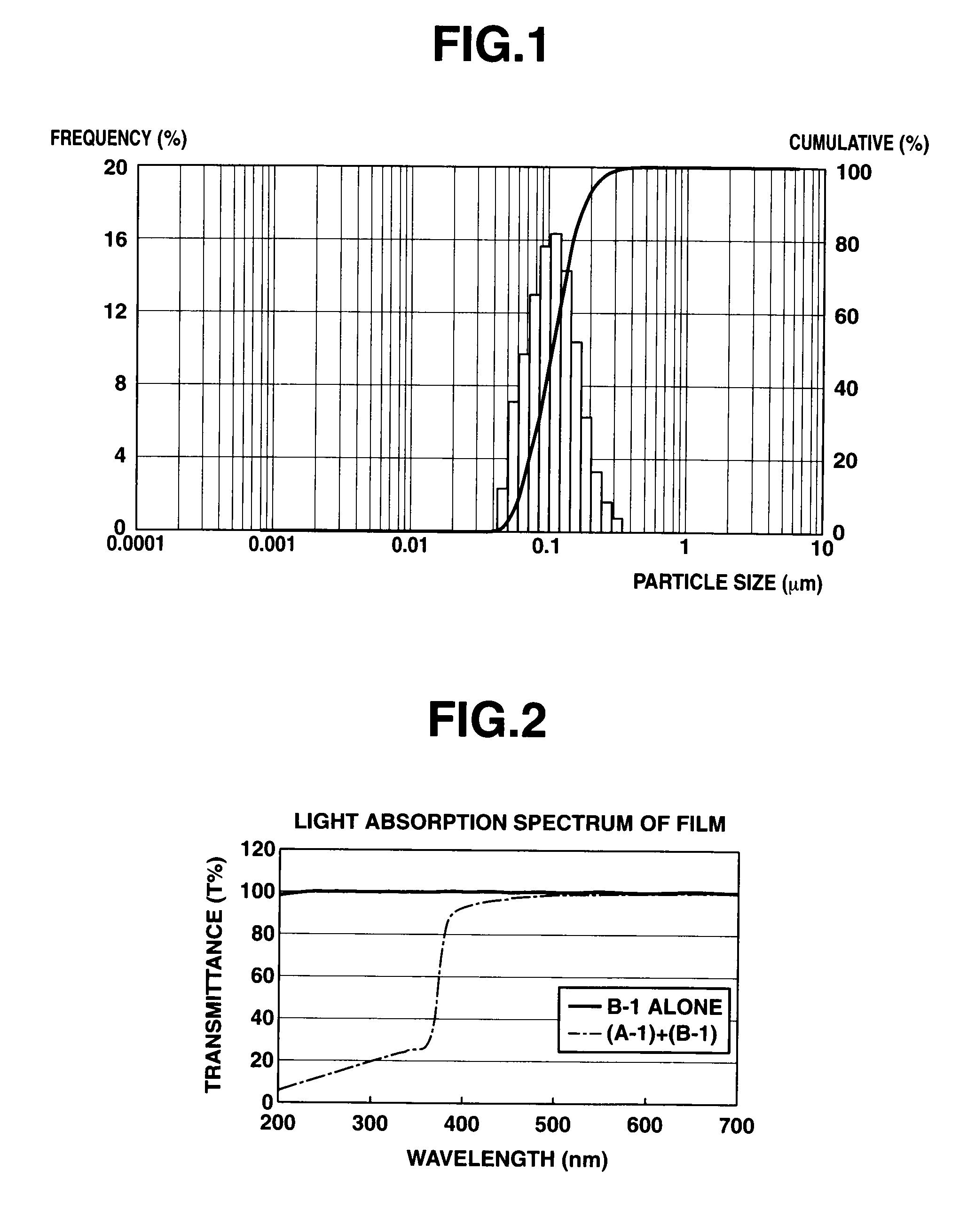Uv-shielding silicone coating composition and coated article
a technology of silicone coating composition and coating article, which is applied in the direction of instruments, lighting and heating apparatus, transportation and packaging, etc., can solve the problems of coating composition stability problems, coating compositions of at least 10 m thick tend to develop cracks, and lack of toughness, etc., to achieve sufficient weather resistance and durability
- Summary
- Abstract
- Description
- Claims
- Application Information
AI Technical Summary
Benefits of technology
Problems solved by technology
Method used
Image
Examples
synthesis example 1
[0142]A 2-L flask was charged with 287 g (2.11 Si-mol) of methyltrimethoxysilane and cooled to a fluid temperature of about 10° C. Then 211 g of Snowtex O (Nissan Chemical Industries, Ltd., water-dispersed silica sol, average particle size 15-20 nm, SiO2 content 20%) and 93 g of 0.25N acetic acid aqueous solution were added dropwise while the flask was cooled so that the internal temperature might not exceed 40° C., allowing hydrolysis to run. Following the dropwise addition, the solution was stirred below 40° C. for one hour and then at 60° C. for 3 hours to bring hydrolysis to completion.
[0143]Thereafter, 300 g of cyclohexanone was poured to the reaction mixture, which was heated under atmospheric pressure until the liquid temperature reached 92° C., for distilling off the methanol resulting from hydrolysis and allowing condensation to run. To the reaction mixture were added 400 g of isopropanol as a diluent, 0.5 g of leveling agent KP-341 (Shin-Etsu Chemical Co., Ltd.), 1.6 g of ...
synthesis example 2
[0144]A 2-L flask was charged with 321 g (2.36 Si-mol) of methyltrimethoxysilane, 21 g (0.13 Si-mol) of 3,3,3-trifluoropropyltrimethoxysilane and 56 g (0.33 Si-mol) of Silicate 35 (Tama Chemicals Co., Ltd., partial hydrolytic condensate of tetraethoxysilane, dimer on average), which were thoroughly mixed. The flask was cooled to a fluid temperature of about 10° C. Then 308 g of 0.25N acetic acid aqueous solution was added dropwise while the flask was cooled so that the internal temperature might not exceed 40° C., allowing hydrolysis to run. Following the dropwise addition, the solution was stirred below 40° C. for one hour and then at 60° C. for 3 hours to bring hydrolysis to completion.
[0145]Thereafter, 300 g of PGMEA was poured to the reaction mixture, which was heated under atmospheric pressure until the liquid temperature reached 92° C., for distilling off the methanol and ethanol resulting from hydrolysis and allowing condensation to run. To the reaction mixture were added 400...
synthesis example 3
[0146]A 2-L flask was charged with 259 g (1.90 Si-mol) of methyltrimethoxysilane and 43 g (0.21 Si-mol) of isocyanurate silane X-12-965 (Shin-Etsu Chemical Co., Ltd., tris(3-trimethoxysilylpropyl)isocyanurate), which were thoroughly mixed. The flask was cooled to a fluid temperature of about 10° C. Then 211 g of Snowtex O (Nissan Chemical Industries, Ltd., water-dispersed silica sol, average particle size 15-20 nm, SiO2 content 20%) and 93 g of 0.25N acetic acid aqueous solution were added dropwise while the flask was cooled so that the internal temperature might not exceed 40° C., allowing hydrolysis to run. Following the dropwise addition, the solution was stirred below 40° C. for one hour and then at 60° C. for 3 hours to bring hydrolysis to completion.
[0147]Thereafter, 300 g of cyclohexanone was poured to the reaction mixture, which was heated under atmospheric pressure until the liquid temperature reached 92° C., for distilling off the methanol resulting from hydrolysis and all...
PUM
| Property | Measurement | Unit |
|---|---|---|
| volume average particle size D50 | aaaaa | aaaaa |
| thick | aaaaa | aaaaa |
| photocatalytic degradability | aaaaa | aaaaa |
Abstract
Description
Claims
Application Information
 Login to View More
Login to View More - R&D
- Intellectual Property
- Life Sciences
- Materials
- Tech Scout
- Unparalleled Data Quality
- Higher Quality Content
- 60% Fewer Hallucinations
Browse by: Latest US Patents, China's latest patents, Technical Efficacy Thesaurus, Application Domain, Technology Topic, Popular Technical Reports.
© 2025 PatSnap. All rights reserved.Legal|Privacy policy|Modern Slavery Act Transparency Statement|Sitemap|About US| Contact US: help@patsnap.com

